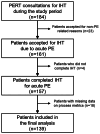Association of transfer time and delays with outcomes for patients with acute pulmonary embolism requiring interhospital transfer: a retrospective observational study
- PMID: 40711763
- PMCID: PMC12302388
- DOI: 10.1080/07853890.2025.2534094
Association of transfer time and delays with outcomes for patients with acute pulmonary embolism requiring interhospital transfer: a retrospective observational study
Abstract
Background: Interhospital transfer (IHT) for pulmonary embolism (PE) is increasingly performed to improve access to advanced reperfusion therapies, but it is unclear if IHT times influence overall outcomes. We studied the association between transfer times and outcomes of patients with acute PE requiring IHT.
Methods: 139 patients with acute PE undergoing IHT to the Mount Sinai Health System between September 2021 and June 2023 were retrospectively studied. Primary outcomes were 30-day mortality and 30-day major bleeding. 'Door to IHT' time was defined as the time from diagnosis of acute PE to the time patient physically arrived in the receiving hospital. Patients were divided into groups based on quartiles of 'door to IHT' time; those within the first and fourth quartiles of 'door to IHT' time were compared using propensity score-weighted analyses. The propensity score was calculated from six variables: age, sex, BMI [Body Mass Index], PESI [PE Severity Index] score, ESC [European Society of Cardiology] risk class and presence of a central PE. Multivariable regression models were fitted within the propensity score-matched sample to assess the association of 'door to IHT' time with primary outcomes.
Results: Median age of included patients was 61 years and 76 (54.7%) were women. Median PESI score was 88 points. Median 'door to IHT' time was 10.8 (IQR: 7.3-19.4) hours. Rates of 30-day mortality and 30-day major bleeding were 7.2% and 2.2%. Within propensity score-weighted analyses, no significant associations were found between 'door to IHT' time and any of the primary outcomes (30-day mortality or 30-day major bleeding).
Conclusion: In this retrospective study of patients with acute PE undergoing IHT, differences in 'door to IHT' time were not significantly associated with 30-day mortality or 30-day major bleeding. This suggests that delays in IHT do not adversely influence outcomes of patients with acute PE undergoing IHT.
Keywords: Pulmonary embolism; embolectomy; mortality; patient transfer; venous thromboembolism.
Conflict of interest statement
R.L. owns stock in Innova Vascular, Summa Medical, ImperativeCare and Thrombolex, and provided consulting services for Penumbra and Boston Scientific. All other authors have no conflict of interests to disclose.
Figures
Similar articles
-
Sex as a prognostic factor for mortality in adults with acute symptomatic pulmonary embolism.Cochrane Database Syst Rev. 2025 Mar 20;3(3):CD013835. doi: 10.1002/14651858.CD013835.pub2. Cochrane Database Syst Rev. 2025. PMID: 40110896
-
Catheter-directed therapies for the treatment of high risk (massive) and intermediate risk (submassive) acute pulmonary embolism.Cochrane Database Syst Rev. 2022 Aug 8;8(8):CD013083. doi: 10.1002/14651858.CD013083.pub2. Cochrane Database Syst Rev. 2022. PMID: 35938605 Free PMC article.
-
Outcomes of catheter-directed embolectomy and surgical embolectomy for intermediate- to high-risk pulmonary embolism: a retrospective observational study.Curr Med Res Opin. 2025 Apr;41(4):713-720. doi: 10.1080/03007995.2025.2494639. Epub 2025 Apr 28. Curr Med Res Opin. 2025. PMID: 40260526
-
Are Patients With Morbid Obesity at Increased Risk of Pulmonary Embolism or Proximal Deep Vein Thrombosis After Lower Limb Arthroplasty? A Large-database Study.Clin Orthop Relat Res. 2024 Jan 1;482(1):115-124. doi: 10.1097/CORR.0000000000002742. Epub 2023 Jul 4. Clin Orthop Relat Res. 2024. PMID: 37404124 Free PMC article.
-
Interventions for preventing venous thromboembolism in adults undergoing knee arthroscopy.Cochrane Database Syst Rev. 2022 Aug 22;8(8):CD005259. doi: 10.1002/14651858.CD005259.pub5. Cochrane Database Syst Rev. 2022. PMID: 35993965 Free PMC article.
References
-
- Salonia JS, Steiger D, Shapiro JM.. Pulmonary embolism response team: a multidisciplinary approach to improve pulmonary embolism management. In: Herzog E., editor. Pulmonary embolism. Cham: Springer International Publishing; 2022. p. 199–207.
Publication types
MeSH terms
LinkOut - more resources
Full Text Sources
Medical

